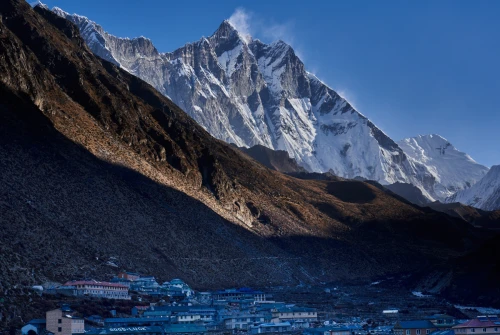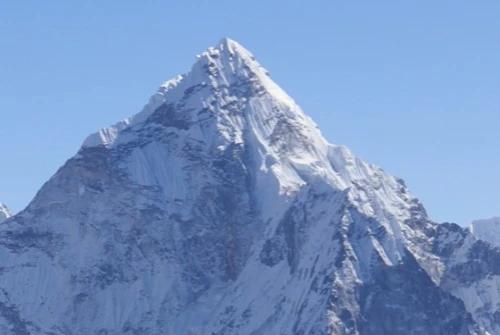The Everest View Trek is a 10-day adventure that takes you through the picturesque landscapes of the Himalayas, offering breathtaking views of Mount Everest and an immersion into the unique Sherpa culture of the region. Everest View Trek is for beginner hikers who desire to witness Mount Everest's beauty without reaching Everest Base Camp. As you progress, you'll encounter charming villages like Namche Bazaar. These places are renowned for their unique cultures and lifestyles. Namche Bazaar may surprise you with its modern amenities and Western cuisine, making it hard to believe you're in a mountainous region.
The villages along the route offer stunning, up-close panoramic views of iconic peaks such as Mt. Everest, Mt. Nuptse, Mt. Thamserku, Mt. Lhotse, and Mt. Ama Dablam. These awe-inspiring sights make this trek one of the most exhilarating experiences in the area. You'll also be captivated by the region's rich flora and fauna, as the trek is part of Sagarmatha National Park. The trail treats you to beautiful Rhododendron, Birch, and Juniper forests, with the Dudhkoshi River flowing at its base, its waters as clear as milk. For those concerned about adapting to the high altitude but still eager to get a close-up view of Everest, this trek is perfect. The villages and settlements along the trail are culturally significant, and the natural beauty is astounding. This trek is truly remarkable!
If you're open to extending the trek's duration, you can explore side trips and visit villages near the main trail or even consider the Everest Three Pass Trek for a more challenging adventure. Best of luck on your journey!
Best Season for Everest View Trek 10 Days
As for the best time for the Everest View trek, it's recommended to plan your trek during the autumn season (September to November) or the spring season (February to May). During these times, the weather is generally stable, with clear skies and pleasant temperatures, making for excellent trekking conditions and providing the best views of the Everest region's stunning landscapes. These months offer a higher chance of clear views of the mountains and a more enjoyable overall trekking experience. However, it's always a good idea to check the latest weather and trail conditions before embarking on your trek.
Permits Required during the Everest View Trek 10 Days
For the Everest Short Trek, also known as the Namche Bazaar Trek, trekkers are required to obtain two permits. The first one is the Khumbu Pasang Lhamu Rural Municipality Permit, which can be acquired in Lukla. The second permit is the Sagarmatha National Park Entrance Permit, as you'll be entering the national park area from Monjo. You can easily obtain the Khumbu Pasang Lhamu Rural Municipality Permit for NPR 2000 for foreigners and the Sagarmatha National Park Entrance Permit for NPR 3000 at the National Park Entrance Gate in Monjo.
Accommodations During the Everest View Trek 10 Days
During the Everest View Trek organized by All Nepal Hiking, you can expect comfortable accommodations. In cities like Kathmandu, we offer 3-star standard category hotels. During the trek itself, including stops in places like Lukla and Namche Bazaar, we provide lodges and tea houses for your stay. The rooms will typically be on a twin/double sharing basis. However, if you prefer a single room, we can arrange it for you at an additional cost. Additionally, if you wish to upgrade the hotel category in Kathmandu or the accommodations in Lukla and Namche, there are options available, and we can accommodate these upgrades with the associated costs, provided we receive prior notice.
Meals during the Everest View Trek 10 Days
Our Everest View Trek package includes breakfasts in Kathmandu and full board meals during the trek in Lukla and Namche Bazaar. In Kathmandu, you'll have a wide range of dining options for lunch and dinner, including a variety of cuisines, beverages, and desserts. Depending on your menu preferences, budget, and desire for authentic experiences, we can recommend the best dining establishments in Kathmandu.
While you're in Lukla and Namche Bazaar, you can enjoy selecting from a diverse range of delicious and nourishing meals. You'll have choices ranging from regional and Asian cuisines to well-known Western dishes. Additionally, there are some delightful cafes and bakeries in these areas that offer options not commonly found on typical trekking routes in Nepal.
Equipment List for Everest View Trek 10 Days
For the Everest View trek, having the right trekking equipment is crucial to ensure your safety and comfort during the journey. A well-prepared trekking equipment list is as follows:
Daypack (25–35 liters): A small backpack to carry essential items during the day, such as water, snacks, extra clothing layers, and personal items.
Pack Cover: To protect your main backpack from rain and snow, ensure your gear stays dry.
Sleeping Bag (comfortable for temperatures around -20°C): A warm sleeping bag is essential for a good night's rest, and you can choose to rent one in Kathmandu if needed.
Waterproof Hiking Boots (optional): Sturdy and waterproof hiking boots with good ankle support for stability on the trek. Waterproof boots are particularly useful in case of rain or snow.
Camp Shoes: Lightweight shoes or booties to wear around the campsite and teahouses during evenings.
LED Headlamp with Extra Battery: Essential for lighting your way during early morning starts or in case you need to move around in the dark.
Trekking Poles: These provide stability, reduce strain on your knees during descents, and help with balance on uneven terrain.
Camelback Water Bladder or Sipper (Water Bottle): Staying hydrated is crucial at high altitudes. A water bladder or reusable sipper bottle is recommended.
Energy Snacks: Carry chocolates, energy bars, and dried fruits for quick energy boosts during the trek.
ORS (Oral Rehydration Salts): Vital for maintaining electrolyte balance and preventing dehydration.
Down Jacket (comfortable for temperatures around -15°C): A warm down jacket is essential for cold mornings and evenings. You can rent or buy one in Kathmandu at a reasonable cost.
T-shirts, Thermal Pants, and Sun Cap: Layering is key to adapting to changing temperatures. T-shirts for daytime, thermal pants for warmth, and a sun cap to protect from the sun.
UV-Protected Goggles: Protect your eyes from the sun's glare and snow reflection.
Waterproof Gloves and Woolen Gloves: Waterproof gloves for wet conditions and woolen gloves for added warmth.
Socks: Woolen socks to keep your feet warm and dry, and carry extra pairs.
Sunscreen, Moisturizer, Lip Balm, and Hand Sanitizer: Protect your skin from the strong sun, and dry air, and maintain hygiene.



 based on 9 reviews
based on 9 reviews
